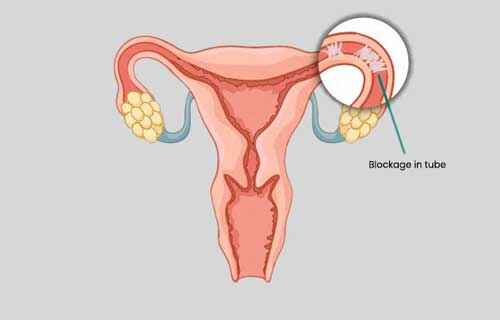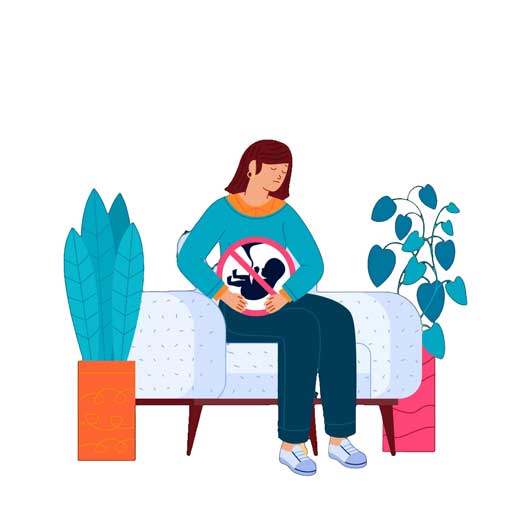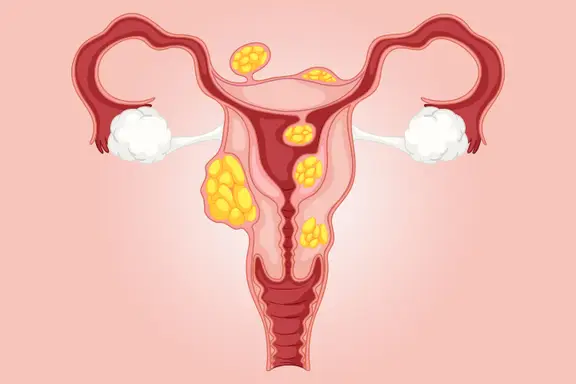
We will be discussing Yoga for Fibroids in this Blog. Fibroids, also known as uterine fibroids or leiomyomas, are benign tumors composed of muscle and fibrous tissue that develop within the uterus. Affecting millions of women worldwide, these growths can vary in size from tiny seeds to large masses and can be classified based on their location: intramural (within the uterine wall), submucosal (just beneath the uterine lining), and subserosal (on the outer wall of the uterus).
Symptoms often include heavy menstrual bleeding, pelvic pain, frequent urination, abdominal swelling, and discomfort during intercourse. These symptoms can significantly impact daily life and overall well-being. While traditional medical treatments such as hormonal medications, nonsteroidal anti-inflammatory drugs (NSAIDs), and surgical options like myomectomy or hysterectomy are commonly utilized, yoga offers a complementary approach that is natural and holistic.
Yoga can assist in managing fibroid symptoms by improving blood flow to the pelvic region, alleviating stress, enhancing digestive health, and supporting hormonal balance. Incorporating specific yoga asanas, along with adopting lifestyle changes such as a balanced diet and regular physical activity, can provide relief and promote a healthier quality of life.

What Are Fibroids?
Fibroids, also known as uterine fibroids or leiomyomas, are non-cancerous tumors made up of muscle and fibrous tissue that develop within the uterus. These growths can vary significantly in size, from as small as a pea to as large as a melon, and may occur as single masses or in clusters. Fibroids are classified based on their location within the uterus:
Intramural Fibroids: These fibroids grow within the wall of the uterus. They are the most common type and can cause the uterus to become enlarged. This enlargement may lead to a variety of symptoms, such as heavy menstrual bleeding, pelvic pain, and discomfort, as the fibroid can push against surrounding organs.
Submucosal Fibroids: These develop just beneath the uterine lining and can protrude into the uterine cavity. Submucosal fibroids are often linked with more severe symptoms, including heavy or prolonged menstrual bleeding, severe cramping, and fertility issues, as they can distort the uterine cavity and affect implantation.
Subserosal Fibroids: Located on the outer wall of the uterus, these fibroids extend into the pelvic cavity. While they might not always cause noticeable symptoms, they can lead to abdominal swelling, pain, and pressure if they press against surrounding organs like the bladder or intestines.
Factors of Fibroids
Fibroids can affect women of reproductive age and are influenced by several factors. Although their exact cause remains unclear, hormonal imbalances, particularly involving estrogen and progesterone, are thought to play a role in their growth. Genetic predisposition is also significant, as a family history of fibroids increases the likelihood of developing them.
Additionally, lifestyle factors such as obesity, poor diet, and lack of physical activity may contribute to their development and exacerbation. Understanding the different types and potential impacts of fibroids can help in managing symptoms and exploring effective treatment options, including lifestyle changes and complementary therapies such as yoga.
Causes of Fibroids
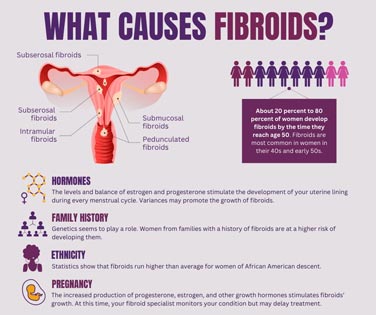
The exact cause of fibroids is not fully understood, but several contributing factors are believed to play a role in their development. Understanding these factors can provide insight into the prevention and management of fibroids.
Hormonal Imbalance
Fibroids are significantly influenced by hormones, particularly estrogen and progesterone, which regulate the menstrual cycle. Estrogen stimulates the growth of the uterine lining, and when levels are elevated, it can lead to the development and growth of fibroids. Progesterone, while less directly involved, also contributes to the hormonal environment that may promote fibroid growth. Women who have higher levels of these hormones, or who have conditions that lead to hormonal imbalance, are at greater risk.
Genetic Factors
Genetics play a crucial role in the likelihood of developing fibroids. Studies indicate that women with a family history of fibroids are more prone to developing them themselves. This suggests that certain genetic predispositions can increase susceptibility to fibroid growth. Research continues to explore the specific genes involved and how they contribute to fibroid development.
Lifestyle Factors
Lifestyle choices and conditions can also influence the risk of developing fibroids. Obesity is one such factor; excess body fat can lead to higher estrogen levels, which may in turn contribute to fibroid growth. A poor diet, particularly one high in red meat and low in fruits and vegetables, may also increase risk. Additionally, a sedentary lifestyle can contribute to weight gain and poor metabolic health, further increasing the likelihood of fibroids. Maintaining a healthy weight through balanced nutrition and regular physical activity is essential for reducing risk.
Environmental Factors
Emerging research suggests that exposure to certain environmental toxins and endocrine disruptors might play a role in fibroid development. These substances can interfere with hormonal balance and potentially contribute to fibroid growth. Reducing exposure to such toxins by choosing organic products and minimizing contact with harmful chemicals may be beneficial.
Age and Reproductive History
Fibroids are more common in women during their reproductive years, particularly between the ages of 30 and 40. Pregnancy and childbirth can influence fibroid development and growth, as the hormonal changes associated with these life stages can impact fibroid behavior.
Understanding these factors helps in identifying preventive measures and exploring effective treatments, including lifestyle changes and holistic approaches like yoga.
Common Symptoms
Fibroids can manifest with a range of symptoms, varying from mild discomfort to severe distress, and some women may experience no symptoms at all. Common symptoms include:
Heavy Menstrual Bleeding: This is one of the most frequent symptoms, characterized by prolonged or excessively heavy menstrual flow. Women may experience soaking through pads or tampons quickly, leading to anemia due to significant blood loss.
Pelvic Pain: Persistent discomfort or aching in the pelvic region can disrupt daily life and activities. This pain may be constant or intermittent, often exacerbated during menstruation or physical activity.
Frequent Urination: If fibroids press against the bladder, they can cause increased urgency and frequency of urination. This can lead to frequent trips to the bathroom and can interfere with daily routines and sleep.
Pain During Intercourse: Fibroids can cause discomfort or pain during sexual activity, affecting intimate relationships and overall quality of life.
Abdominal Swelling: Visible swelling or a feeling of fullness in the abdomen may occur, particularly with larger fibroids. This can contribute to physical discomfort and may make clothes fit differently, adding to the psychological and physical burden.
Understanding these symptoms can help in early detection and effective management, including exploring supportive treatments like yoga and lifestyle modifications.
How Yoga for Fibroids help in managing it
Yoga is a holistic practice that offers a range of benefits for managing fibroids and alleviating their symptoms. Through the combination of physical postures (asanas), breathwork (pranayama), and meditation, yoga can support overall health and improve quality of life for those affected by fibroids. Yoga plays a significant role in symptom management and overall well-being. Here’s how:
Enhancing Blood Circulation by Yoga for Fibroids
Certain yoga poses are particularly effective in boosting blood flow to the pelvic region, which can help reduce pain and inflammation associated with fibroids. Improved circulation ensures that oxygen and nutrients are delivered more effectively to tissues, supporting the body’s natural healing processes. Poses such as Forward Fold (Uttanasana) and Bridge Pose (Setu Bandhasana) are known to increase blood flow to the pelvis and lower abdomen, helping to alleviate discomfort and promote healing.
Reducing Stress by Yoga for Fibroids

Stress has a profound impact on hormonal balance and can exacerbate fibroid symptoms by increasing levels of stress hormones like cortisol. Yoga’s emphasis on relaxation and mindfulness helps mitigate stress through practices such as deep breathing, meditation, and gentle movement. Techniques such as Child’s Pose (Balasana) and Legs-Up-the-Wall Pose (Viparita Karani) promote deep relaxation and can help in managing the emotional and physical stress that exacerbates fibroid symptoms.
Improving Digestion by Yoga for Fibroids
Yoga supports digestive health, which is crucial for managing symptoms such as bloating and constipation that are often associated with fibroids. Specific poses stimulate the digestive organs and can enhance gastrointestinal function. For example, poses like Supine Spinal Twist (Supta Matsyendrasana) and Cat-Cow Pose (Marjaryasana-Bitilasana) encourage gentle abdominal massage and improve digestion, helping to alleviate discomfort and support regular bowel movements.
Enhancing Hormonal Balance by Yoga for Fibroids
Regular yoga practice contributes to hormonal balance by reducing stress and promoting overall well-being. Certain asanas, combined with breath control and meditation, can help regulate the menstrual cycle and potentially influence the growth and development of fibroids. Yoga practices like Pranayama (breathwork) and restorative poses help in balancing hormones and supporting a healthy menstrual cycle, which may positively impact fibroid-related symptoms.
Incorporating yoga into your daily routine, along with other healthy lifestyle choices, can provide significant relief from fibroid symptoms and support a balanced, healthy life.
Recommended Asanas in Yoga for Fibroids
Incorporating yoga into your routine can be highly beneficial for managing fibroid symptoms. Specific asanas can provide relief from discomfort, improve circulation, and support overall well-being. Here’s an in-depth look at some recommended poses, including detailed instructions, benefits, and tips for each:
Child’s Pose (Balasana)
Description: Child’s Pose, or Balasana, is a restorative yoga pose that gently stretches the back, hips, and thighs. It’s particularly helpful for relieving lower back pain and promoting relaxation.
How to Perform:
- Start Position: Kneel on the floor, touching your big toes together and sitting back on your heels. Keep your knees spread apart about hip-width.
- Movement: Extend your arms forward, placing your palms flat on the floor. Slowly lower your torso between your thighs, resting your forehead on the mat.
- Breathing: Breathe deeply and evenly, allowing your body to sink into the pose with each exhale. Hold the position for 1-2 minutes, or as long as comfortable.
Benefits:
- Relieves Lower Back Pain: By gently stretching the lower back and hips, Child’s Pose can alleviate discomfort and tension in the lower back.
- Promotes Relaxation: The forward fold and resting position help calm the nervous system and reduce stress.
- Improves Flexibility: This pose stretches the spine, thighs, and hips, contributing to increased flexibility.
Tips:
- Use Props: If your forehead does not reach the mat, use a bolster or folded blanket to support your head.
- Focus on Breath: Engage in slow, deep breathing to enhance relaxation and deepen the stretch.

Cat-Cow Pose (Marjaryasana-Bitilasana)
Description: Cat-Cow Pose, or Marjaryasana-Bitilasana, is a dynamic sequence that combines two poses to enhance spinal flexibility and relieve lower back pain. It involves moving between arching and rounding the spine.
How to Perform:
- Start Position: Begin on all fours with your wrists directly under your shoulders and knees under your hips.
- Cat Pose: Inhale and arch your back, lifting your head and tailbone towards the ceiling while drawing your belly towards the floor.
- Cow Pose: Exhale and round your spine, tucking your chin towards your chest and drawing your belly button towards your spine.
- Movement: Continue to flow between Cat and Cow Pose for 1-2 minutes, synchronizing your breath with the movements.
Benefits:
- Enhances Spinal Flexibility: The alternating movements of arching and rounding help increase flexibility and mobility in the spine.
- Alleviates Lower Back Pain: This pose gently massages the back muscles and improves circulation, providing relief from lower back discomfort.
- Improves Posture: By engaging the core and lengthening the spine, Cat-Cow Pose supports better posture.
Tips:
- Keep Movements Smooth: Ensure a gentle transition between poses to avoid strain.
- Engage Core Muscles: Maintain engagement in your abdominal muscles to support your lower back.

Forward Fold (Uttanasana)
Description: Forward Fold, or Uttanasana, is a standing pose that stretches the hamstrings, lower back, and calves. It helps relieve tension and promotes relaxation.
How to Perform:
- Start Position: Stand with your feet hip-width apart and your arms by your sides.
- Movement: Inhale and lengthen your spine, then exhale as you fold forward from your hips. Let your head hang heavy and keep your knees slightly bent if necessary.
- Position: Place your hands on the floor, shins, or a block for support. Hold the position for 1-2 minutes, breathing deeply.
Benefits:
- Stretches Hamstrings and Lower Back: The forward bend targets the hamstrings and lower back, relieving tension and tightness.
- Reduces Stress: The inversion and forward fold help calm the mind and promote a sense of relaxation.
- Improves Circulation: Hanging the head below the heart aids in increasing blood flow to the brain and upper body.
Tips:
- Use Support: If you can’t reach the floor, use yoga blocks or place your hands on your shins.
- Avoid Over-Stretching: Keep the knees slightly bent to protect the lower back and hamstrings.
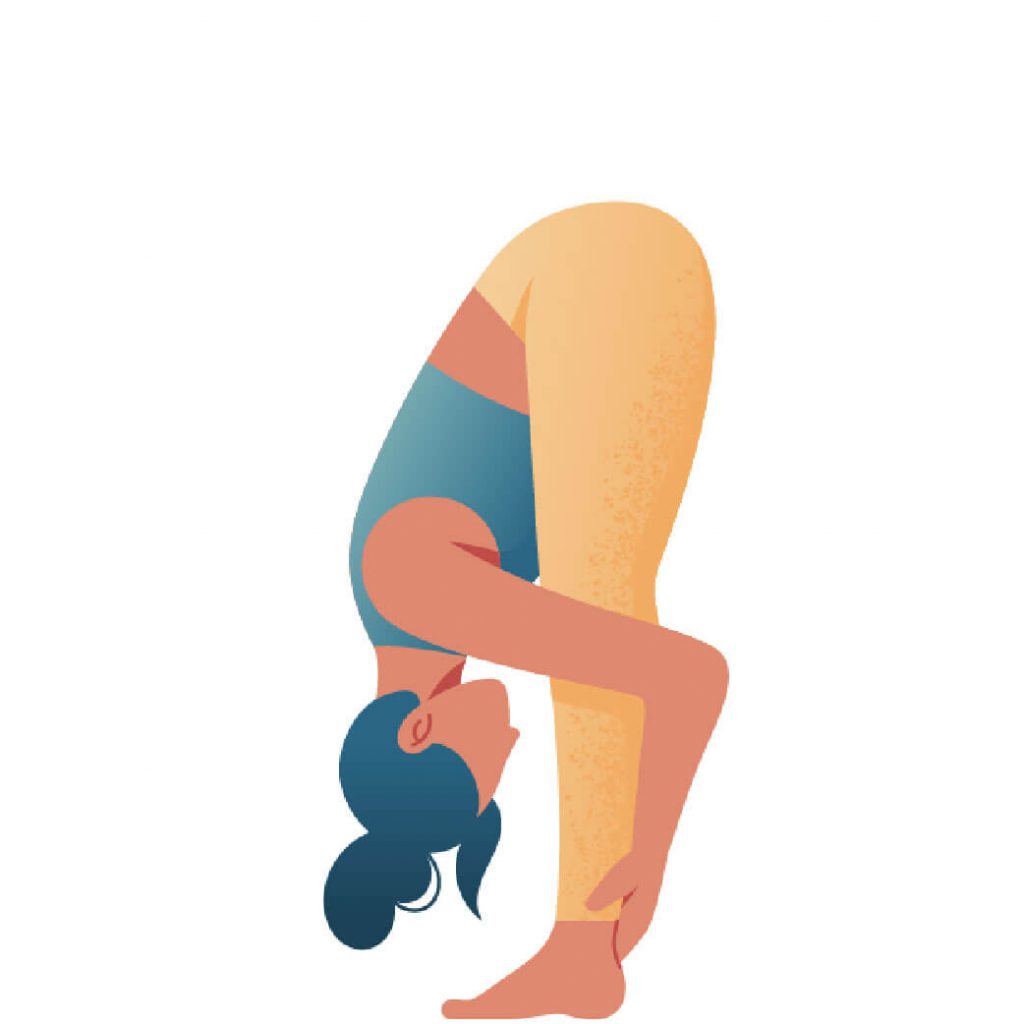
Bridge Pose (Setu Bandhasana)
Description: Bridge Pose, or Setu Bandhasana, strengthens the lower back, glutes, and pelvic region. It’s beneficial for supporting pelvic health and improving core strength.
How to Perform:
- Start Position: Lie on your back with your knees bent and feet hip-width apart. Place your arms by your sides with palms facing down.
- Movement: Press your feet into the mat as you lift your hips towards the ceiling. Clasp your hands under your back, interlacing your fingers.
- Position: Hold the pose for 30 seconds to 1 minute, then slowly lower your hips back to the mat.
Benefits:
- Strengthens Lower Back and Glutes: By lifting the hips, Bridge Pose engages and strengthens the muscles of the lower back and buttocks.
- Supports Pelvic Health: The pose stimulates the pelvic organs and can help alleviate discomfort associated with fibroids.
- Improves Circulation: Lifting the hips above the heart enhances blood flow to the pelvic region.
Tips:
- Engage Core Muscles: Activate your core muscles to support your lower back and maintain stability.
- Avoid Overarching: Ensure that the lower back does not over-arch; focus on engaging the glutes and thighs.

Supine Spinal Twist (Supta Matsyendrasana)
Description: Supine Spinal Twist, or Supta Matsyendrasana, is a restorative pose that promotes relaxation and supports digestive health. It helps release tension in the lower back and abdomen.
How to Perform:
- Start Position: Lie on your back with your arms extended to the sides and knees bent.
- Movement: Gently drop your knees to one side while turning your head in the opposite direction. Keep your shoulders grounded and breathe deeply.
- Position: Hold for 1-2 minutes, then switch sides.
Benefits:
- Relieves Lower Back Tension: The twist helps release tension in the lower back and hips, providing relief from discomfort.
- Promotes Digestive Health: The gentle abdominal compression stimulates digestion and can alleviate bloating.
- Enhances Relaxation: The pose calms the nervous system and helps reduce stress.
Tips:
- Keep Shoulders Grounded: Ensure your shoulders stay connected to the mat to avoid straining the upper back.
- Use Props: Place a bolster or blanket under your knees for added support if needed.

By incorporating these yoga asanas into your routine, you can effectively manage fibroid symptoms and enhance overall well-being. Remember to practice these poses regularly and listen to your body to achieve the best results.
Incorporating Complementary Lifestyle Changes during Yoga for Fibroids
In addition to practicing yoga, incorporating specific lifestyle changes can significantly enhance the management of fibroids and overall well-being. Here’s a comprehensive guide to dietary adjustments, regular exercise, stress management, and adequate sleep:
Dietary Adjustments during Yoga for Fibroids
Increase Fiber Intake
A diet rich in fiber supports a healthy digestive system and helps maintain a healthy weight, which is beneficial for managing fibroids. To increase fiber intake, aim to consume more fruits, vegetables, legumes, and whole grains. Fiber regulates bowel movements and prevents constipation, which can reduce bloating and discomfort associated with fibroids. Moreover, a high-fiber diet supports balanced weight management, influencing fibroid development positively.
Limit Red Meat
Research suggests a potential link between high red meat consumption and an increased risk of fibroids. Reducing your intake of beef, pork, and lamb can help lower your risk. Opt for leaner protein sources like poultry, fish, and plant-based proteins. Limiting red meat not only helps in potentially reducing fibroid risk but also promotes overall health by lowering the intake of saturated fats and cholesterol.
Incorporate Anti-Inflammatory Foods
Anti-inflammatory foods can help reduce inflammation, which may alleviate fibroid symptoms. Incorporate foods rich in omega-3 fatty acids, such as flaxseeds, chia seeds, walnuts, and fatty fish like salmon and mackerel. Omega-3 fatty acids have anti-inflammatory properties that can help reduce swelling and discomfort associated with fibroids while supporting overall hormonal balance.
Additional dietary tips include staying hydrated by drinking plenty of water, which supports digestion and overall health. Avoid processed foods high in sugar, salt, and unhealthy fats, as these can exacerbate inflammation and contribute to weight gain.
Regular Exercise
Engaging in regular physical activity helps maintain a healthy weight, improves circulation, and supports overall well-being. Combining yoga with other forms of exercise, such as walking, swimming, or cycling, can provide comprehensive benefits. Regular exercise not only helps manage weight, which is important for reducing fibroid risk, but also promotes healthy circulation, potentially alleviating symptoms like pelvic pain and bloating.
To incorporate exercise effectively, set realistic goals, such as aiming for at least 150 minutes of moderate-intensity exercise per week. Choose activities you enjoy to stay motivated and consistent with your routine.
Stress Management
Managing stress is crucial for reducing fibroid symptoms, as high stress levels can exacerbate symptoms and influence hormonal imbalances. Techniques such as mindfulness, meditation, and deep breathing can help reduce stress and improve emotional well-being. Mindfulness focuses on the present moment, while regular meditation practice can calm the mind and body, reducing stress levels. Deep breathing exercises also help in relaxing and lowering stress.
To manage stress effectively, set aside time each day for relaxation and stress-reducing activities. Consistently incorporating mindfulness, meditation, or deep breathing into your daily routine can enhance stress management and overall health.
Adequate Sleep
Prioritizing quality sleep is essential for overall health and supports the body’s natural repair and regeneration processes. Aim for 7-8 hours of restful sleep each night. Quality sleep helps regulate hormones, supports immune function, and manages stress. It also plays a role in maintaining a healthy weight and reducing inflammation.
To improve sleep quality, establish a consistent routine by going to bed and waking up at the same time each day. Create a relaxing sleep environment by keeping it cool, dark, and quiet. Additionally, limit screen time at least an hour before bedtime to reduce exposure to blue light, which can interfere with sleep.
By integrating these complementary lifestyle changes into your routine, you can further support the management of fibroids and improve your overall health. A balanced diet, regular exercise, effective stress management, and adequate sleep collectively contribute to a holistic approach in managing fibroid symptoms and enhancing your quality of life.
Creating a Routine to practice Yoga for Fibroids
Integrating yoga into your daily life can be a transformative way to manage fibroids and enhance overall well-being. Here are key tips to help you establish an effective yoga routine:
Start Slow
Begin with gentle, beginner-friendly poses if you are new to yoga. This approach helps you familiarize yourself with basic movements and builds foundational strength and flexibility.
Benefits: Starting slow reduces the risk of injury and allows your body to adapt gradually to the new physical demands. It also helps you build confidence in your practice.
Consistency is Key
Aim to practice yoga regularly, ideally 3-4 times per week. Consistent practice helps you develop muscle memory, improve flexibility, and experience the full range of benefits yoga offers.
Benefits: Regular practice enhances your ability to manage fibroid symptoms effectively, supports hormonal balance, and promotes overall health. Consistency ensures that you reap the long-term benefits of yoga.
Listen to Your Body
Pay close attention to how your body feels during and after each yoga session. Modify poses as needed based on your comfort level and any symptoms you may experience.
Benefits: Listening to your body helps prevent overexertion and injury. It also allows you to tailor your practice to your specific needs, ensuring that it remains safe and effective.
Seek Guidance
Consider joining a yoga class or working with a certified instructor who can provide personalized guidance. An experienced instructor can help you perform poses correctly and offer modifications tailored to your condition.
Benefits: Professional guidance ensures that you practice yoga safely and effectively, enhancing the therapeutic benefits and preventing potential injuries. Personalized instruction can also address specific concerns related to fibroids and overall health.
By following these tips, you can create a yoga routine that supports the management of fibroids and contributes to your overall well-being. Embrace the practice with patience and dedication, and remember that each step you take in your yoga journey brings you closer to improved health and balance.
Conclusion
Yoga provides a holistic and integrative approach to managing fibroids, offering a range of benefits that can significantly enhance overall well-being. While it is not a cure for fibroids, incorporating yoga into your daily routine can be a powerful adjunct to traditional treatments, contributing to symptom relief and improved quality of life.
Holistic Benefits of Yoga for Fibroids
Yoga combines physical postures, breathwork, and mindfulness practices that address various aspects of health, making it an excellent complementary therapy for managing fibroids. By incorporating specific asanas (poses) into your practice, you can enhance blood circulation to the pelvic area, which may help alleviate pain and reduce inflammation associated with fibroids. Additionally, yoga’s focus on relaxation and stress reduction can be particularly beneficial, as stress can exacerbate fibroid symptoms by influencing hormonal balance.
Supporting Symptom Relief
Incorporating yoga poses such as Child’s Pose (Balasana), Cat-Cow Pose (Marjaryasana-Bitilasana), Forward Fold (Uttanasana), Bridge Pose (Setu Bandhasana), and Supine Spinal Twist (Supta Matsyendrasana) into your routine can provide targeted relief for fibroid symptoms. These asanas help with reducing pelvic pain, relieving lower back tension, improving digestion, and promoting overall relaxation. Complementing these practices with lifestyle changes such as a balanced diet, regular exercise, and effective stress management further supports symptom relief and enhances overall well-being.
Complementary Lifestyle Changes
To maximize the benefits of yoga, integrating complementary lifestyle changes is crucial. A diet rich in fiber, anti-inflammatory foods, and maintaining a healthy weight can support overall health and reduce fibroid-related symptoms. Regular physical activity and adequate sleep also play essential roles in managing fibroids and improving your quality of life.
Embracing Yoga for Balance and Healing
Yoga encourages a mindful approach to health, fostering a sense of balance and inner peace. By adopting a consistent yoga practice, you cultivate a deeper awareness of your body and its needs, allowing you to manage fibroids more effectively. Embracing the power of yoga helps you to not only address physical symptoms but also to enhance emotional resilience, contributing to a more harmonious and balanced life.
In conclusion, while yoga alone may not replace conventional medical treatments, it serves as a valuable adjunct therapy for those managing fibroids. By integrating yoga into your routine and making supportive lifestyle changes, you can improve your well-being, reduce symptoms, and foster a healthier, more balanced life.
